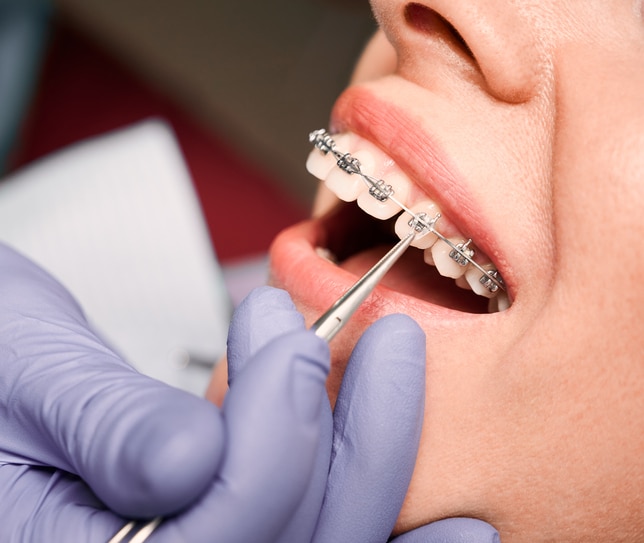What Establishes Cumming Braces and Aligners In Addition To Various Other Orthodontic Treatments
What Establishes Cumming Braces and Aligners In Addition To Various Other Orthodontic Treatments
Blog Article
Comprehensive Guide to Orthodontics Procedures for Fixing Dental Imbalances
In the realm of orthodontics, the trip to achieving a perfectly straightened smile includes a myriad of procedures customized to correct dental imbalances. From typical braces to unseen aligners and even surgical options, the field of orthodontics supplies a variety of options to deal with differing degrees of oral abnormalities. Comprehending the ins and outs of each procedure, including their devices, benefits, and prospective disadvantages, is critical in making informed decisions concerning one's orthodontic treatment. As we navigate via the comprehensive guide to orthodontic procedures for correcting dental misalignments, the intricate details of each method will unravel, clarifying the course towards a unified and practical dental alignment.
Orthodontic Procedures Overview

In addition to clear aligners and conventional dental braces, orthodontists may additionally recommend various other interventions like headwear, palatal expanders, or retainers to deal with specific positioning issues (cumming invisalign). These procedures are customized per client's one-of-a-kind needs and might entail a combination of treatments to attain the desired outcomes. Routine adjustments and tracking are vital components of orthodontic therapy to make sure development gets on track and to make any needed adjustments along the road. By going through orthodontic treatments, people can not only achieve a straighter smile but likewise enhance their overall dental wellness and feature.
Typical Dental Braces: Exactly How They Function
When thinking about orthodontic treatments for dental misalignments, standard braces stand apart as a tried and true technique for fixing teeth positioning. Standard braces contain braces, cables, and bands that function together to apply continual stress on the teeth, slowly relocating them into the desired positioning. The brackets are connected to the teeth using an unique adhesive, and the cables are threaded via the brackets. By readjusting the tension of the cables, orthodontists can control the instructions and force used to each tooth, directing them right into proper positioning over time.
As stress is used to the teeth via the dental braces, the bone bordering the teeth is reshaped to support the new tooth settings. Individuals will certainly need routine modifications at the orthodontist's workplace to ensure the braces proceed to use the proper stress for reliable teeth activity.
Invisible Aligners: Pros and Cons
These clear, customized trays are essentially unseen when used, making them an appealing alternative for individuals looking for a much more aesthetically pleasing orthodontic therapy. Clients can get rid of the aligners before consuming or brushing their teeth, minimizing the risk of food obtaining stuck in Discover More Here the appliance and streamlining the cleaning procedure.

Surgical Orthodontic Options
Surgical interventions in orthodontics present practical options for resolving complicated oral misalignments that may not be efficiently solved via standard orthodontic therapies. While unnoticeable aligners and conventional braces can correct many orthodontic concerns, particular situations need surgical treatment to attain ideal results. Surgical orthodontic options are typically suggested for extreme malocclusions, substantial jaw inconsistencies, and situations where the underlying bone structure requires adjustment to achieve proper placement.
One typical surgical orthodontic treatment is orthognathic surgical treatment, which includes rearranging the jaws to remedy functional concerns such as problem talking or chewing. This surgical procedure is commonly done in cooperation with an orthodontist that helps straighten the teeth before and after the treatment. Surgical orthodontics may also include procedures to subject impacted teeth, get rid of excess gum cells, or reshape the jawbone to produce a more unified facial account.
Before taking into consideration medical orthodontic options, individuals undergo a thorough assessment to establish the requirement and potential benefits of such treatments. cumming orthodontist. While surgery might appear difficult, it can significantly enhance both the feature and looks of the smile in cases where standard orthodontic treatments fall short
Retainers and Post-Treatment Treatment

Post-treatment care entails following the orthodontist's guidelines vigilantly. This might consist of proper oral health methods, going to follow-up consultations, and putting on the retainers as suggested. Failure to abide with post-treatment treatment instructions can lead Learn More Here to regression, where the teeth progressively return in the direction of their initial placements. Consistent retainer wear, good oral health, and regular oral exams are important for preserving the results accomplished via orthodontic surgical treatment and making certain the lasting security of the dealt with oral positioning.
Final Thought
To conclude, orthodontic procedures offer numerous choices for fixing dental imbalances. Typical dental braces use steel braces and cables to shift teeth right into appropriate positioning. Undetectable aligners supply a more discreet alternative yet might not be suitable for all cases. Surgical orthodontic alternatives are offered for much more severe imbalances. Retainers are frequently used post-treatment to keep the new placement. Generally, orthodontic procedures can efficiently boost dental health and aesthetic appearance.
As we navigate via the comprehensive overview to orthodontic treatments for correcting dental imbalances, the elaborate information of each method will certainly unfold, dropping light on the path toward a useful and harmonious oral alignment. - orthodontics
One of the most typical orthodontic treatments is the use of dental braces, which are composed of metal brackets and cords that apply gentle stress to progressively shift teeth right into the wanted position.When taking into consideration orthodontic treatments for dental imbalances, traditional braces stand out as a tried and true technique for dealing with teeth placing. Furthermore, invisible aligners may not be appropriate for complicated orthodontic concerns that call for even more substantial teeth activity, as they are typically recommended for mild to moderate cases. Retainers are customized orthodontic gadgets designed to hold teeth in their fixed positions after the completion of orthodontic treatment.
Report this page